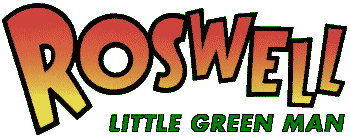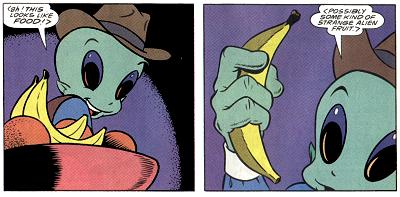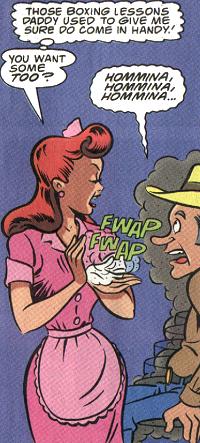Roswell: Little Green Man

 In the beginning (of Bongo Comics) there was Steve Vance, who managed to make Matt Groening’s Simpsons-related comic book line exceed everyone’s expectations. It was actually as amusing and subversive as the television series, more than forumlaic kiddie comics based on a hit TV show. But when Vance (and his colorist wife Cindy Vance) left, the books lost their edge, and stopped exceeding expectations.
In the beginning (of Bongo Comics) there was Steve Vance, who managed to make Matt Groening’s Simpsons-related comic book line exceed everyone’s expectations. It was actually as amusing and subversive as the television series, more than forumlaic kiddie comics based on a hit TV show. But when Vance (and his colorist wife Cindy Vance) left, the books lost their edge, and stopped exceeding expectations.
One bright spot in the post-Vance Bongo has been Bill Morrison. He writes and/or illustrates a good Simpsons story, so I was curious to see what he would do writing and drawing his own characters. Roswell is a first for the Bongo imprint: a series featuring characters not created (or owned) by Groening; it’s not even set in the Simpsons universe. {gasp!}
 For those not up on UFO conspiracies, Roswell is the site in New Mexico where something crashed in the desert back in 1947. Many believe it was an alien space craft, covered up by the U.S. military. According to Morrison’s tale, there was a flying saucer that crashed, stranding a hapless three-foot cute-as-a-button little green man, who is the protagonist of our story.
For those not up on UFO conspiracies, Roswell is the site in New Mexico where something crashed in the desert back in 1947. Many believe it was an alien space craft, covered up by the U.S. military. According to Morrison’s tale, there was a flying saucer that crashed, stranding a hapless three-foot cute-as-a-button little green man, who is the protagonist of our story.
Roswell is clearly intended to be fun… at least I thought it was. With a cowboy who rides a mutant (remember the pre-Hiroshima nuclear test done in the American Southwest?) elephant-sized rabbit named Dagnabbit, a waitress named Julienne Fryes, an alien whose real name sounds like… well, I better not say {grin}, and two pages at the back of Roswell #1 featuring real try-them-at-home recipes of Roswell’s favourite foods from home…. you can tell that Morrison doesn’t take it overly seriously.
 It’s not all silliness, however; Morrison gets some jabs in here and there, indicating that this comic is a product of the cynically enlightened 90’s, not the naively paranoid 40’s. In one scene, Julienne explains that she’s a pilot and cutting-edge inventor with an engineering degree from the University of Michigan… but the only job she can get since the War ended is waiting tables at a diner, because of all the male G.I.s returning from Europe and the Pacific. It also touches upon racism; not all of the people on Roswell’s home planet of Zoot are green, you see. Like Groening has done in the Simpson’s books, Morrison takes a page for an “editorial”, such as wistful reflection on the loss of things… and people like his mother. (The series has a breezy and fun 2-page letters column as well, I should add… Morrison didn’t commandeer that for his editorials.)
It’s not all silliness, however; Morrison gets some jabs in here and there, indicating that this comic is a product of the cynically enlightened 90’s, not the naively paranoid 40’s. In one scene, Julienne explains that she’s a pilot and cutting-edge inventor with an engineering degree from the University of Michigan… but the only job she can get since the War ended is waiting tables at a diner, because of all the male G.I.s returning from Europe and the Pacific. It also touches upon racism; not all of the people on Roswell’s home planet of Zoot are green, you see. Like Groening has done in the Simpson’s books, Morrison takes a page for an “editorial”, such as wistful reflection on the loss of things… and people like his mother. (The series has a breezy and fun 2-page letters column as well, I should add… Morrison didn’t commandeer that for his editorials.)
Julienne is the perfect 1940’s woman for the 90’s: smart, independent, tough under pressure, and pretty. Likewise, Morrison’s art is a fine blend of retro and modern. It’s actually a bit depressing, because it reminds me how little careful, cartoony art there is in comics these days. Imagine a somewhat simplified Will Eisner Spirit with (fairly restrained) modern coloring. The fact that this is “cartoon” art isn’t used as an excuse for sloppiness or hyper-simplification (e.g. the Simpsons, Dilbert, LuAnn). Each character has a distinct “look” which is maintained in every panel they appear in.
Morrison accomplishes this level of quality in part by taking three months to complete each issue. But he addresses this by providing the necessary reminders of What Came Before at the beginning of each issue. On the first page of Roswell #3, Julienne complains about how long they’ve been waiting since the cliffhanger at the end of the previous issue, and Morrison appears on panel to apologise.
If you’ve been passing Bongo by since Steven and Cindy Vance left, Roswell is well worth a look. It’s not the work of a ascerbic comedic genius like Groening or even Vance, but it’s a well-done and entertaining romp through a time gone by, when the biggest worries were rowdies in pick-up trucks, alien invaders, and the occasional commie.
The truth is elsewhere.
